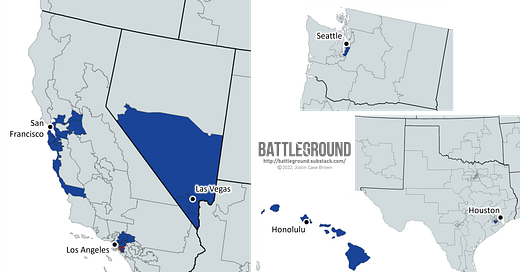Majority-Minority Districts: The New West
Districts where Asian Americans and Pacific Islanders have a seat at the table.

What is the New West?
Majority-minority districts in the New West stand out for their higher prevalence of Asian American and Pacific Islander voters.
While nearly all currently support Democrats, these districts are more politically diverse than many other majority-minority districts. At least four are considered swing districts in the upcoming midterm elections.
Walking through the New West
Hawaii’s House districts exemplify the qualities of this group the best. In both of the state’s districts, Asian Americans makeup the largest ethnic group and Pacific Islanders rank as the second largest voting group. Both of their current House representatives are high ranking members of the Congressional Asian Pacific American Caucus and Rep. Kahele is retiring from his seat to run for Governor of Hawaii.
California’s New West districts are split between the metro areas of San Francisco and Los Angeles. In Northern California, these majority minority districts line the San Francisco Bay and stretch east up toward Sacramento. In Southern California, the districts are clustered east of Los Angeles in the San Gabriel Valley.
Three of Nevada’s four districts are majority minority and hold fairly large Asian American and Pacific Islander populations. In NV-3, as many as 1 in 4 voters identify as a part of the AAPI community. In addition, both Washington and Texas have congressional districts that hold fairly large Asian American communities (WA-9 and TX-7 respectively.)
These districts tend to be more politically diverse than other majority-minority districts (outside of Northern California) and don’t support the Democratic party by blowout margins. At least four districts are considered swing districts in the upcoming House elections and one (CA-45) is currently represented by a Republican. This helps highlight the importance of advocating for these communities as these voters typically don’t have deep historical ties to either political party.
Stopping AAPI Hate
During the COVID-19 pandemic, many conservatives used hateful, marginalizing rhetoric against the AAPI community as a way to garner populist support. This resulted in an uptick in violence against Asian Americans and scrambled previous patterns of political support. In the late 20th century, Asian Americans were trending toward Republicans: 55% of voters within the community supported George H.W. Bush’s presidential run over Bill Clinton in 1992. Fast forward to 2020, Asian Americans (specifically in Georgia) were partially responsible for ejecting Trump from office as their turnout surged by 40% compared to 2016, the largest increase for any demographic group in the country.
Members of the AAPI community are done with being used as political pawns and are embracing their new found agency via their advocates in the US House. Members of the Congressional Asian Pacific American Caucus were instrumental in passing the Covid-19 Hate Crimes Act which gave the Department of Justice jurisdiction to investigation hate crimes that primarily affect the AAPI community. In addition, many of these communities are receiving direct outreach from both political parties as they’re increasingly painted as coveted persuadable voters.




